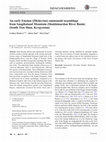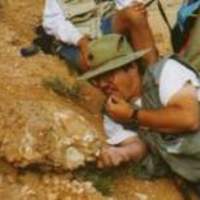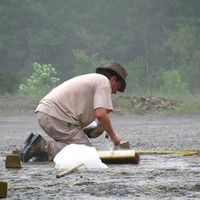Papers by Svetlana Nikolaeva
Бюллетень Московского общества испытателей природы. Отдел геологический, 2019
In connection with the search for а marker of the lower boundary of the global Serpukhovian Stage... more In connection with the search for а marker of the lower boundary of the global Serpukhovian Stage, proposed as FAD of the conodont Lochriea ziegleri, it is necessary to study in detail the morphology P1 elements of the genus Lochriea and to clarify the diagnostic characters of each species, including the ancestral one. As an aid to researchers on this difficult path, a list of publications has been compiled containing images of conodonts attributed to the genus Lochriea, in the form of traditional synonyms, but without revising the taxonomic position of the illustrated forms.

Palaeobiodiversity and Palaeoenvironments, 2017
Early Emsian (Zlichovian) ammonoids are recorded from a section of neritic deposits on the wester... more Early Emsian (Zlichovian) ammonoids are recorded from a section of neritic deposits on the western and northwestern slopes of Sangibaland Mountain (right bank of the Shakhimardan River, near the village of Jiydelik, South Fergana, South Tien Shan, Kyrgyzstan) including other faunas such as conodonts, dacryoconarids, brachiopods, trilobites, and corals. The ammonoid fauna includes Erbenoceras cf. solitarium (Barrande, 1865), E. kimi Bogoslovsky, 1980 and new species of teicherticeratids. This combination of taxa allows the host beds to be correlated with the Zlichovian LDIII Zone. Ammonoids come from the Katran Formation, from beds previously recognised as the Sandal Formation, which is well-known for its neritic assemblages, interpreted as inhabitants of shallow shelf zones in the northern regions of the Paleozoic Alai-Tarim Terrane. Near the end of the Zlichovian, when the Dalejan transgression spread to the Sangibaland Region, ammonoids colonised the neritic basin near a carbonate platform, already inhabited by abundant benthic fauna. The co-occurrence of neritic and pelagic organisms is a useful feature providing a basis for the correlation between the pelagic and neritic successions of the lower Emsian (Zlichovian).

PalZ
The Devonian–Carboniferous boundary beds in the Berchogur (Birshogyr) sections in the Mugodzhary ... more The Devonian–Carboniferous boundary beds in the Berchogur (Birshogyr) sections in the Mugodzhary (Mugalzhary) Mountains in western Kazakhstan, known to contain various fossil groups, including ammonoids, conodonts, foraminifers, corals, crinoids, and trilobites, are re-examined. The siliciclastic-carbonate succession of the Zhangana Formation reveals the presence of several ammonoid, conodont, and foraminiferal zones. The succession contains the Acutimitoceras ammonoid Genozone, equivalent to the level of the Stockum ammonoid fauna of Germany, with the conodont Siphonodella sulcata appearing within the Genozone. The same beds show mass occurrences of the foraminifer Tournayellina pseudobeata. The study of the Berchogur sections began in the 1980s; these sections are among very few successions globally with ammonoids of the Acutimitoceras Genozone in association with conodonts and foraminifers. At that time, several outcrops in a small area in the upper reaches of Burtybai (Zhangansa...

The Bulletin of zoological nomenclature, 2009
The recent description of the fossil primate Darwinius masillae in the online journal PLoS ONE ex... more The recent description of the fossil primate Darwinius masillae in the online journal PLoS ONE exemplifies an increasingly common problem: nomenclatural acts in non-print venues that are not considered 'published' under the Code's Articles 8.6 and 9.8. Although the name Darwinius was subsequently validated by the publication of hardcopy offprints of the electronic paper, other zoological names have been published electronically in this and other online journals, and the broader taxonomic community's acceptance of these invalidly published names suggests that it is the Code itself that is outdated in refusing to recognise names accepted by everyone else. If the Code is not quickly changed to accommodate electronic publication, it will become marginalised and ignored, to the detriment of sense and stability in nomenclature. The increasing prevalence of electronic publishing leaves only a small window of opportunity in which the Code can act to regulate nomenclatural ac...

Palaeoworld, 2019
This paper aims to evaluate potential biostratigraphic markers for the Viséan-Serpukhovian bounda... more This paper aims to evaluate potential biostratigraphic markers for the Viséan-Serpukhovian boundary in sections of Europe and Asia, to help identify the base of the global Serpukhovian Stage, which is a high priority task for Carboniferous biostratigraphy. Sections in the Serpukhovian stratotype area in the Moscow Basin precisely correlated with other successions worldwide. The IUGS Task Group to establish a GSSP close to the traditional Viséan-Serpukhovian boundary focused on the search for a new boundary marker, primarily on the first appearance datum (FAD) of the conodont Lochriea ziegleri in the lineage Lochriea nodosa to Lochriea ziegleri, considering it to be a suitable biostratigraphic event. The FOD (first occurrence datum) of L. ziegleri has been recognized in many successions worldwide, although only in a few sections the supposed evolutionary lineage of L. ziegleri was inferred. There are serious impediments to the FAD of L. ziegleri being universally accepted as the boundary marker. This paper presents a review of the FOD levels of L. ziegleri documented so far from multiple sections along with other correlatable markers (foraminifers and ammonoids) that can serve as additional points of reference in sections where a conodont record is poor or absent. The reviewed sections are Naqing Section (South China), Verkhnyaya Kardailovka and Kugarchi sections (South Urals, Russia), Mariinsky Log and Ladeinaya Mountain sections (western slope of the
Stratigraphy, 2017
TheKugarchi Section in the Zilair Synclinorium in the SouthUrals (Russia, Bashkortostan) is one o... more TheKugarchi Section in the Zilair Synclinorium in the SouthUrals (Russia, Bashkortostan) is one of themost complete sections of the Bukharcha Formation, including the entire Serpukhovian and the lower Bashkirian. This is the type section of the Bogdanovkian Regional Infrasubstage ('Horizon'), the lowermost Bashkirian of the Urals. The section spans the Visean-Serpukhovian andMid-Carboniferous boundaries and contains various ammonoids, conodonts, and foraminifers, providing a good basis for the regional stratigraphy and global correlations. The section has been measured and logged, and its microfacies and fossils are identified in this study.

Stratigraphy and Geological Correlation, 2017
Verkhnyaya Kardailovka section is one of the best candidates for the GSSP (Global Stratotype Sect... more Verkhnyaya Kardailovka section is one of the best candidates for the GSSP (Global Stratotype Section and Point) at the base of the Stage (Mississippian). For boundary definition, the first appearance of the conodont Lochriea ziegleri Nemirovskaya, Perret et Meischner, 1994 in the lineage Lochriea nodosa (Bischoff, 1957)−L. ziegleri is used. L. ziegleri appears in the Venevian Substage somewhat below the base of the Serpukhovian in the Moscow Basin. The position of the FAD of L. ziegleri within the Hypergoniatites−Ferganoceras Genozone is confirmed and lies between 19.53 and 19.63 m above the section's base. Before 2010, deep-water stylonodular limestone containing the boundary in unnamed formation C at Kardailovka was well exposed but only 3 m of Viséan strata cropped out immediately below. Recent trenching exposed another 10 m of underlying Viséan carbonates in formation C and older Viséan siliciclastics and volcanics in unnamed formation B. The contact between formation B and underlying crinoidal limestones in unnamed formation A representing the middle Viséan Zhukovian (Tulian) regional Substage was excavated. The boundary succession, situated in the Magnitogorsk tectonic zone above the Devonian Magnitogorsk arc and Mississippian magmatic and sedimentary rift succession, was deposited west of the Kazakhstanian continent during closure of the Ural Ocean. In the lower part of the section, Viséan tuffaceous siliciclastics and volcanics of formation B record rapid deepening after deposition of neritic middle Viséan crinoid lime grainstone of formation A and subsequent subaerial exposure. The overlying condensed upper Viséan to Serpukhovian succession in formation C comprises deep-water limestone deposited in a sediment-starved basin recording minor turbidite influx and carbonate-mound development. The δ 13 C carb plot shows a positive shift of 1‰ V-PDB (from +2 to +3‰) between 17.0 and 17.75 m (3.05 and 1.97 m below FAD L. ziegleri). The δ 18 O apatite graph displays a prominent upward shift from 19.9 to 21.1‰ V-SMOW (at 19.15 to 19.51 m) in the nodosa Zone below FAD of Lochriea ziegleri.
Paleontological Journal, 2017
Eifelian ammonoids are described for the first time from the Central Kyzylkum Desert (Uzbekistan,... more Eifelian ammonoids are described for the first time from the Central Kyzylkum Desert (Uzbekistan, Navoiy Region, Aristantau Mountains). The ammonoid assemblage includes the typical Eifelian genera Fidelites, Subanarcestes (a new species S. aristanensis Nikolaeva sp. nov. is described), and Cabrieroceras, found in association with brachiopods, conodonts, and dacryoconarids. The ammonoid assemblage is similar to that from the Choteč beds of Barrandien and their equivalents in the Urals, Salair, Germany, and Morocco (Subanarcestes macrocephalus Zone), suggesting a connection between the Eifelian Kyzylkum Basin, which was part of the Turkestan Paleoocean, and European, North African, Siberian, and Uralian basins. The ammonoids studied are not associated with black shale and apparently existed in normal marine environments.

The Journal of eukaryotic microbiology, Jul 6, 2017
Recent advances in molecular technology have revolutionized research on all aspects of the biolog... more Recent advances in molecular technology have revolutionized research on all aspects of the biology of organisms, including ciliates, and created unprecedented opportunities for pursuing a more integrative approach to investigation of biodiversity. However, this goal is complicated by large gaps and inconsistencies that still exist in the foundation of basic information about biodiversity of ciliates. The present paper reviews issues relating to the taxonomy of ciliates and presents specific recommendations for best practice in the observation and documentation of their biodiversity. This effort stems from a workshop that explored ways to implement six Grand Challenges proposed by the International Research Coordination Network for Biodiversity of Ciliates (IRCN-BC). As part of its commitment to strengthening the knowledge base that supports research on biodiversity of ciliates, the IRCN-BC proposes to populate The Ciliate Guide, an online database, with biodiversity-related data and...
Paleontological Journal, 2007

Geological Society, London, Special Publications, 2021
The Carboniferous chronostratigraphic scale consists of two subsystems, six series and seven stag... more The Carboniferous chronostratigraphic scale consists of two subsystems, six series and seven stages. Precise numerical age control within the Carboniferous is uneven, and a global magnetic polarity timescale for the Carboniferous is far from established. Isotope stratigraphy based on Sr, C and O isotopes is at an early stage but has already identified a few Sr and C isotope events of use to global correlation. Cyclostratigraphy has created a workable astrochronology for part of Pennsylvanian time that needs better calibration. Chronostratigraphic definitions of most of the seven Carboniferous stages remain unfinished. Future research on the Carboniferous timescale should focus on Global Stratotype Section and Point (GSSP) selection for the remaining, undefined stage bases, definition and characterization of substages, and further development and integration of the Carboniferous chronostratigraphic scale with radioisotopic, magnetostratigraphic, chemostratigraphic and cyclostratigrap...
Biological Reviews, 2017
An exhaustive study of existing data on the relationship between egg size and maximum size of emb... more An exhaustive study of existing data on the relationship between egg size and maximum size of embryonic shells in 42 species of extant cephalopods demonstrated that these values are approximately equal regardless of taxonomy and shell morphology. Egg size is also approximately equal to mantle length of hatchlings in 45 cephalopod species with rudimentary shells. Paired data on the size of the initial chamber versus embryonic shell in 235 species of Ammonoidea,

Organisms Diversity & Evolution
Governance is the act of governing or organizing, that is a system of rules, norms, or shared str... more Governance is the act of governing or organizing, that is a system of rules, norms, or shared strategies to guide or regulate the actions of the governed. Since the initial development of Linnaean taxonomy, a diversity of approaches have been adopted for critical taxonomic decisions, introducing pluralism to taxonomic principles and resulting in disagreements about the development of species lists. These disagreements are in part a product of the fragmented governance structure that has developed for the creation of taxonomic lists. To address these challenges and achieve the goal of a single, accepted list of life on Earth, a new governance structure for the development of taxonomic lists is needed. Here, we introduce three high-level categories of governance structure-fragmentation, monocentric governance, and polycentric governance-which differ in the way decision-making power is distributed and coordinated. We then show the problems caused by the fragmented governance structure currently in place for the development of taxonomic lists and consider the potential for a new approach grounded in either monocentric or polycentric governance. Both monocentric and polycentric approaches have the potential to address the problems inherent in the existing fragmented system. Ultimately, the best governance system for taxonomic lists will be the one that the taxonomic community is prepared to accept.
Organisms Diversity & Evolution
A global consensus list of the world's species must be based on the best available taxonomic rese... more A global consensus list of the world's species must be based on the best available taxonomic research, and its contents should not be biased towards certain political or social aims. At the same time, users of any global list must be involved or consulted in its establishment to ensure that the list meets their needs. This paper argues that while these two desiderata-independence and inclusion-might seem to be in conflict, they are in fact compatible. More precisely, it suggests the roles taxonomists and users could play in establishing and maintaining a global consensus list to make sure that this list is both inclusive and independent.

PLOS Biology
Lists of species underpin many fields of human endeavour, but there are currently no universally ... more Lists of species underpin many fields of human endeavour, but there are currently no universally accepted principles for deciding which biological species should be accepted when there are alternative taxonomic treatments (and, by extension, which scientific names should be applied to those species). As improvements in information technology make it easier to communicate, access, and aggregate biodiversity information, there is a need for a framework that helps taxonomists and the users of taxonomy decide which taxa and names should be used by society whilst continuing to encourage taxonomic research that leads to new species discoveries, new knowledge of species relationships, and the refinement of existing species concepts. Here, we present 10 principles that can underpin such a governance framework, namely (i) the species list must be based on science and free from nontaxonomic considerations and interference, (ii) governance of the species list must aim for community support and use, (iii) all decisions about list composition must be transparent, (iv) the governance of validated lists of species is separate from the governance of the names of taxa, (v) governance of lists of accepted species must not constrain academic freedom, (vi) the set of criteria considered sufficient to recognise species boundaries may appropriately vary between different taxonomic groups but should be consistent when










Uploads
Papers by Svetlana Nikolaeva